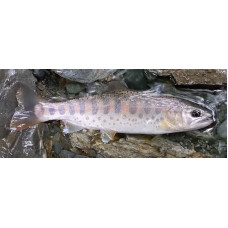Latin name
Oncorhynchus masou
Other names
Masu, cherry trout, salmon trout.
Identification
It has a spindle-shaped, streamlined, somewhat laterally compressed body covered with fine scales. There are 130-240 scales on the lateral line. The body is relatively large, its height ranging from 28 to 31% of the body length. The length of the upper jaw is 14.9-17.1 in males and 12.6-13.2% of the body length in females. In breeding males, the upper jaw lengthens and curls into a hook, and powerful fang-like teeth grow on both jaws. Eye diameter decreases sharply with age, from 20-30% of head length in juveniles (up to 200 mm) to nearly 10% in adults. Branchiostegal rays are 11-15. Gill rays are very short, 18-22. There are 63-66 vertebrae in the vertebral column. Pyloric appendages 35-76.
Features of fish fins
The dorsal fin has 13-18 soft rays, the anal fin has 14-18 soft rays. The pelvic fins have an axillary projection. Like all salmonids, it has an adipose fin between the dorsal and caudal fins. The unpaired fins are small and the anal fin has a prominent notch that distinguishes Masu salmon from other salmonids. The caudal fin is notched. The notch on the caudal fin is prominent.
Fish colouring
Similar in appearance to coho or small Chinook salmon, but the black spots on the body are larger and much more numerous. They cover the back and sides of the fish, as well as the dorsal and tail fins. Masu salmon are very brightly colored when mating: their olive body is covered with red and crimson horizontal stripes, light crimson when entering the river, and darker when spawning.
Distribution
Coastal waters and rivers of the northwestern Pacific Ocean (65°N - 34°N, 127°E - 158°E). The species' range extends along eastern Asia, from Kamchatka, the Kuril Islands, Sakhalin and Primorsky Krai, Russia, southward through Korea, Taiwan and Japan.
Habitat
Marine, freshwater, brackish, benthopelagic, anadromous. Depth range 0-200 m. Prefers temperate climates.
Size
Reaches 79 cm in length and a mass of 10 kg.
Behavior
It is divided into two forms:
Passing, when the small fish rolls into the sea, after 3-4 years returns to the river to spawn as a large fish, about 0.5 m long and more. Such fish enters the rivers of Kamchatka, Sakhalin, Primorye, Hokkaido and Hondo, and goes south along the mainland coast to Busan and the Tumannaya River;
Resident, when the small fish for some reason does not roll into the sea, but stays in the river. They have a length of about 15-20 cm and a constant variegated coloration. Catches are mainly dwarf males. The resident form lives in mountain rivers of Japan, Taiwan, Sakhalin, Primorye and Khabarovsk Krai.
Food and feeding habits
Unlike other Pacific salmon, Masu salmon can feed in fresh water. In the ocean, it feeds heavily on crustaceans and rarely on juvenile fish.
Reproduction
Spawning runs occur from April to early July. Spawning grounds are usually found in the upper reaches of rivers and major tributaries. As with all other species, eggs are laid in nests on gravelly bottoms with weak currents. After spawning, all individuals die. Despite the fact that the fish begins to rise to spawn in the spring, spawning itself occurs in late summer - early fall, before spawning it is in the upper reaches of spawning rivers and streams. The passage form dies after spawning, while the resident form (mainly dwarf males) participates in spawning the following year. Juveniles live in freshwater for up to a year or more; mature in the 3-4th year of life. The period of marine life lasts 2-3.5 years, depending on the age of the fry.
Fishing
It is a valuable commercial species. It is harvested in the sea (bays, coves) when it approaches the coast to spawn. There is usually no commercial fishing in rivers.
Relationship with a person
This fish has a specific and unique taste. Its flesh contains omega fatty acids, selenium, amino acids and many vitamins.
Interesting facts
Masu salmon used to lay their eggs in the ocean. However, there were fewer enemies and more favourable conditions for maturation in rivers, so the instinct changed and the fish began to lay their eggs in fast-flowing rivers. Salmon establish spawning grounds in areas with overhanging banks and fallen trees. These shelters provide favourable hydrological conditions for spawning and the development of eggs.
| Classification | |
| Phylum | Chordata |
| Class | Actinopterygii |
| Squad | Salmoniformes |
| Family | Salmonidae |
| Genus | Oncorhynchus |
| Species | O. masou |
| Features | |
| Conservation status | Endangered |
| Habitat | Pelagic |
| Life span, years | No information |
| Maximum body weight, kg | 10 |
| Maximum length, cm | 79 |
| Sailing speed, m/s | No information |
| Threat to people | Edible |
| Way of eating | Predator |
Masu salmon
Tags: masu salmon



